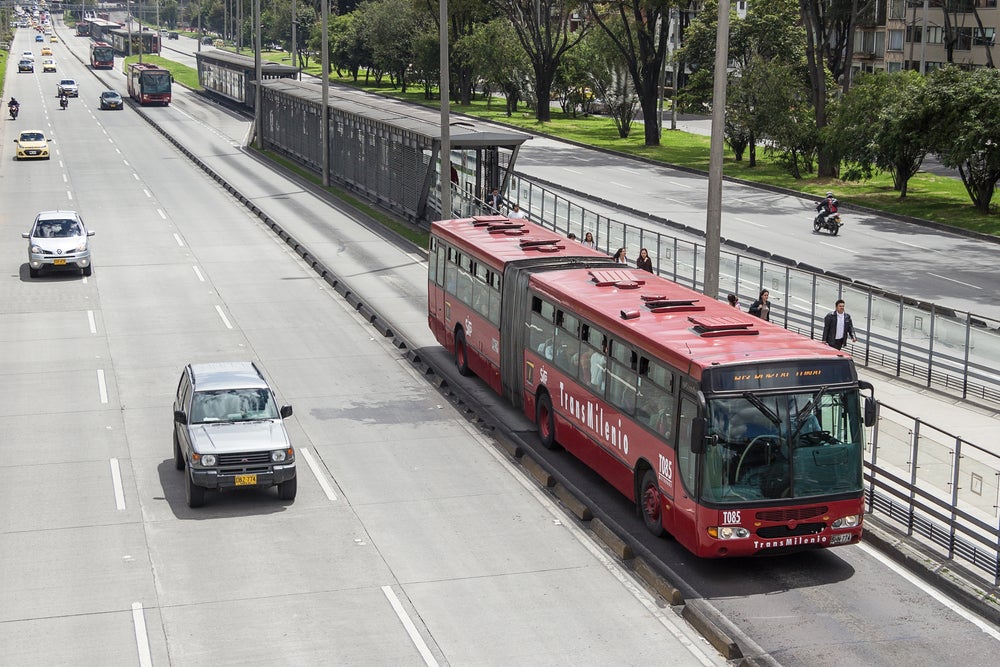Confronted with sprawling development and paralyzing traffic, cities throughout Latin America and the Caribbean have moved to built rapid transit systems, ranging from subways to bus rapid transit systems (BRTs). New rapid transit, government officials hope, will get people out of their cars, improve the environment and boost wellbeing and productivity.
But demonstrating the effectiveness of these systems can prove elusive. The large numbers of actors and the extremely complex relationships between them can overwhelm existing measuring tools and make effective design and planning of a subway or BRT challenging in the extreme.
So an innovative new way of gauging how mass transport affects cities, proposed in a paper by economist Nick Tsivanidis, could not come at more opportune moment. Planners typically evaluate new transport systems in terms of how they reduce travelling time. But Tsivanidis introduces a concept known as commuter market access (CMA) to assess how new transport changes workers’ access to places with good jobs, a measure that includes several economic benefits. He uses a similar method to evaluate how it affects firms and their ability to access workers.
Tsivandis’ approach lies in creating a coherent model to simultaneously evaluate how a transport system changes multiple dimensions of a city’s economy: its population movements, employment, and housing prices as well as how it shapes the behavior of different groups, including less and more educated workers, landlords and firms. Most importantly, it shows, with numerous different data sources, how a mass transit system can allow workers greater mobility and in the process generate a better match-up between workers and firms that enhances overall productivity.
Examining a mass transit system in Colombia
Tsivanidis’s thought-provoking paper was presented September 9 at the Urbanization and Poverty Reduction Research Conference, co-organized by the IDB, the World Bank, George Washington University and the International Growth Centre. It specifically examines Transmilenio, the world’s largest BRT, which opened in Bogotá in the year 2000 and currently provides 2.2 million trips per day throughout most of the city at speeds comparable to those of the New York City subway.
The study holds some good news for cities that want to build BRTs like Transmilenio, with its stations and single use bus lanes. BRTs are not only far cheaper and faster to build than subways, with similar reductions in travel time. They can result in greater productivity and significant welfare gains for the population as a whole, including for both less educated and more educated workers.
Transmilenio was designed so that its transit lines, like spokes around a wheel, converged in the central and north central parts of the city where the largest and most productive firms are located. Critical to that design was the establishment of feeder buses, which take riders at no additional charge to locations beyond the end of the lines, thus solving what economists and planners call “the last mile problem.” Tsivanidis shows in fact that the largest impact of Transmilenio came from the feeder buses.
This overall design opened up new horizons for less educated workers who lived in the city’s poorer south. It allowed them to travel to the city center and find jobs there that best matched their abilities and paid higher wages among the city’s most productive firms.
Gains didn’t only go to the poor
It also benefited more skilled and wealthier workers — those with secondary-level education or higher — giving them welfare gains more or less equal to those of the poor. This is surprising given that the poor tend to use public transport much more than the wealthy. But higher skilled workers, like computer engineers or corporate lawyers, don’t have many options. They can only find work at more productive firms, such as those located in Bogotá’s city center. And with their commute times to the city center shortened, Transmilenio gave them more time for work and leisure.
Firms were big winners too. They were more able to employ people from the far flung regions of the city who couldn’t access the city center before. And because of that bigger supply of workers from which to choose, they could better match workers to jobs and increase productivity.
Significantly, Transmilenio generated changes that went far beyond reductions in travelling time and access to jobs. Greater firm productivity and expansion in the city center meant that commercial rents rose, benefitting landlords but eating into some of the firms profits. Better access to good jobs in the city’s poor south encouraged more people to move near the Transmilenio lines, increasing competition for housing and rents and similarly benefitting landlords, but eating into worker’s wages.
Some of these effects might have been mitigated. By lifting building restrictions, for example, Tsivanidis estimates that Bogotá would have been able to ease pressure on rents and increase welfare gains by 25%.
Mass transit that delivers a boost to GDP
Still, the new system increased real income by around 1.6% among both low and high skilled workers. It also hiked the city’s GDP by 1.4%, even after the cost of building and operating the new system, with 60% to 80% of those gains coming from people having more time for leisure and work and 20% to 40% from improved allocation of labor.
Today, more than 200 cities have BRTs, most of them built in the last two decades in Latin America and Asia. These are not universally successful, as a recent study of Jakarta, also presented at the conference, shows. But Tsivanidis’s research reveals that such systems can result in large benefits in terms of city output and worker welfare as workers get better access to high paying jobs and firms get better access to workers. Moreover, those gains can be maximized if cities ensure that feeder buses take workers beyond the end of the transit lines to their final destinations and if they remove housing restrictions that limit supply and hike rents.


Leave a Reply